Session 1: Body Organization, Tissues & Homeostasis
Workshop 1 Overview
Homeostasis
Body organisation
Tissues
Integumentary system
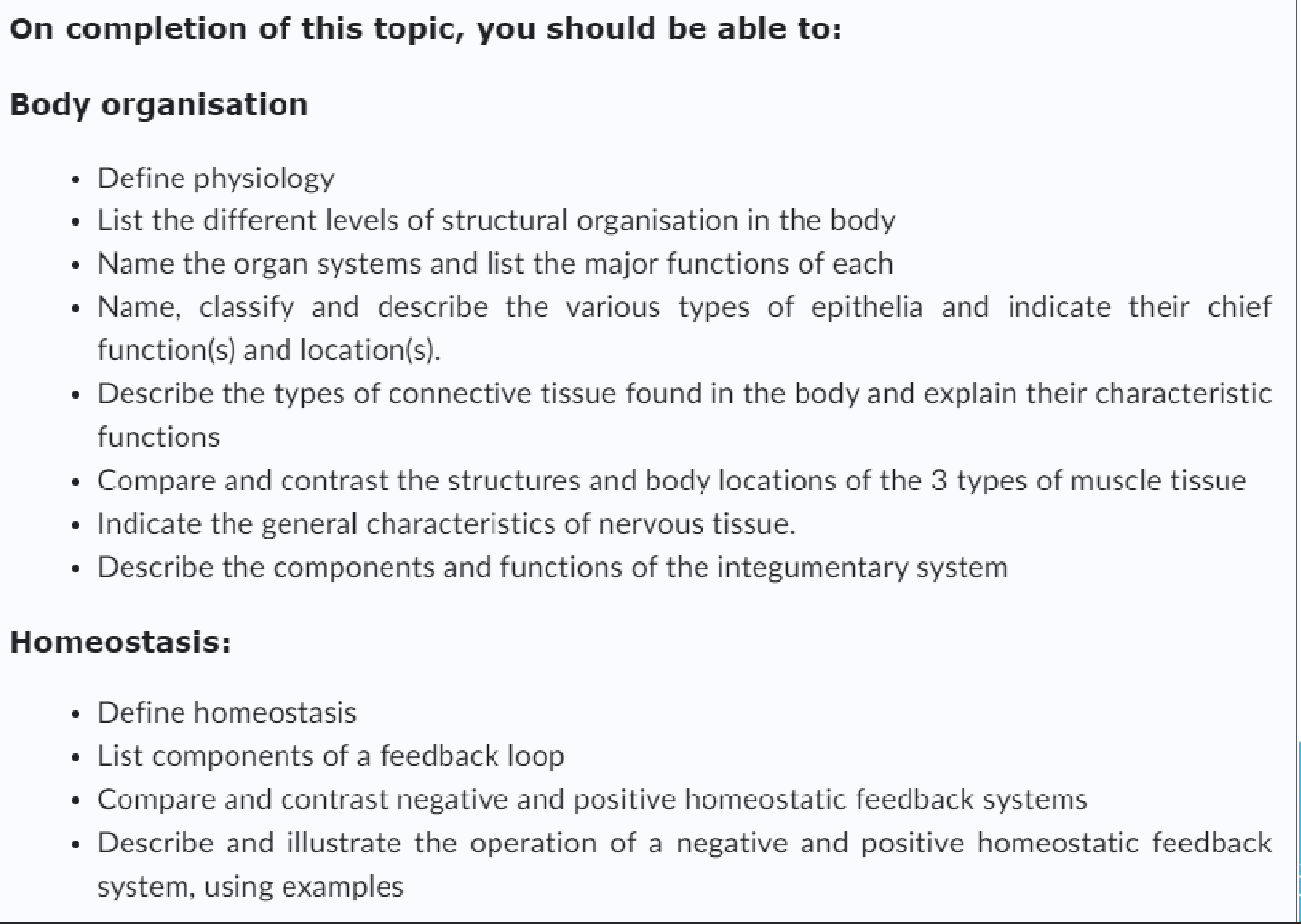
Physiology
Physiology focuses on the functions of the body
Considers the operation of specific organ systems
Renal physiology (kidney function)
Neurophysiology (nervous system function)
Cardiovascular physiology (heart and blood vessels function)
Also requires a knowledge of basic physical and chemical principles (e.g., electrical currents, pressure, and movement)
Anatomy: the study of structure
Anatomy and physiology are inseparable
Function always reflects structure
What a structure can do depends on its specific form
The 7 Core Concepts of Physiology
STRUCTURE & FUNCTION
Structure and function are intrinsically related at all levels of the organism.
PHYSIOLOGICAL ADAPTATION
Organisms adjust and adapt to acute and chronic changes in the internal and external environments across the lifespan.
HOMEOSTASIS
The internal environment of the organism is actively regulated by the responses of cells, tissues, and organs through feedback systems.
CELL MEMBRANE
Cellular membranes determine which substances enter or leave the cell or its compartments.
They are essential for cell signalling, transport, and function.
CELL-TO-CELL COMMUNICATION
The function of the organism requires that cells pass information to one another to coordinate their activities.
MOVEMENT OF SUBSTANCES
The movement of substances (ions or molecules) is a fundamental process that occurs at all levels of organisation in the organism.
INTEGRATION
Cells, tissues, organs, and organ systems interact to create and sustain life.

Homeostasis
Homeo: like, similar
Stasis: standing still or in a state of equilibrium
Maintenance of a relatively stable internal environment despite continuous changes in the external environment
(internal environment = inside body)
(external environment = outside body)
Homeostasis ensures that cells live in constant conditions.
Involves continuous monitoring and regulation of many variables (e.g. Glucose, O2 & CO2, water, Na+, K+, Ca2+, fats, temperature, pressure )
Imbalances are corrected by the Nervous and endocrine systems via nerve impulses and hormones
Feedback Loop Components
(reseptor/afferent pathway/control center/efferent pathway/effector)
Stimulus: Produces change in variable.
Receptor: Detects change.
Input: Information sent along afferent pathway to control center.
Control Center: analyzes input from the receptor, and coordinates an appropriate response
Output: Information sent along efferent pathway to effector.
Effector: whatever responds to stimuli
Response of effector feeds back to reduce the effect of stimulus and returns variable to homeostatic level.
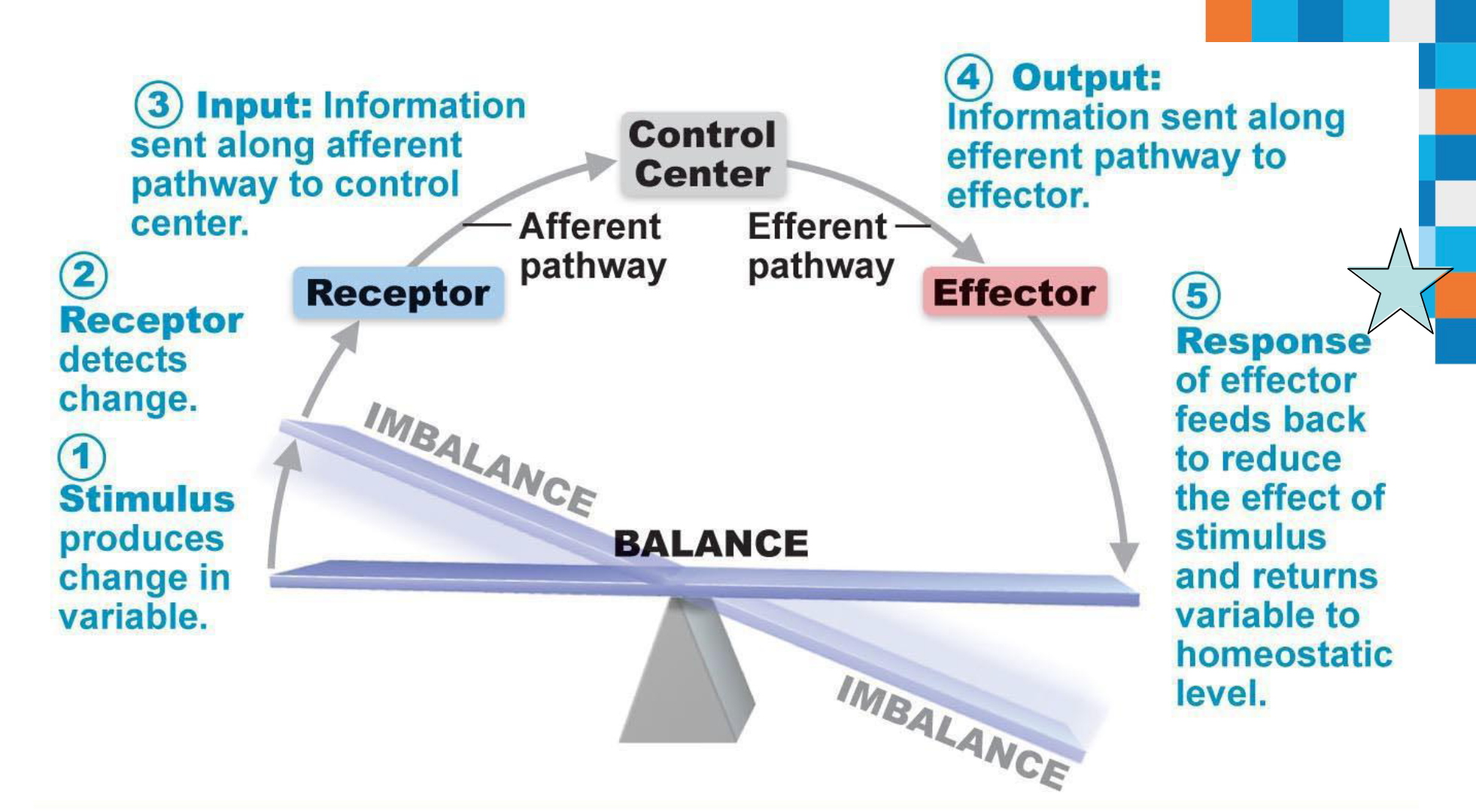
Negative Feedback
The response reduces or shuts off the original stimulus
Example: Temperature regulation
Temperature Regulation (example)
Stimulus: Body temperature rises
Receptors: Temperature-sensitive cells in skin and brain
Afferent pathway: Information sent along the afferent pathway to control center
Control Center: Thermoregulatory center in brain
Efferent pathway: Information sent along the efferent pathway to effectors
Effectors: Sweat glands
Response: Sweat glands activated, evaporation of sweat; Body temperature falls; stimulus ends
Stimulus: Body temperature falls
Receptors: Temperature-sensitive cells in skin and brain
Afferent pathway: Information sent along the afferent pathway to control center
Control Center: Thermoregulatory center in brain
Efferent pathway: Information sent along the efferent pathway to effectors
Effectors: Skeletal muscles
Response: Shivering begins; Body temperature rises; stimulus ends
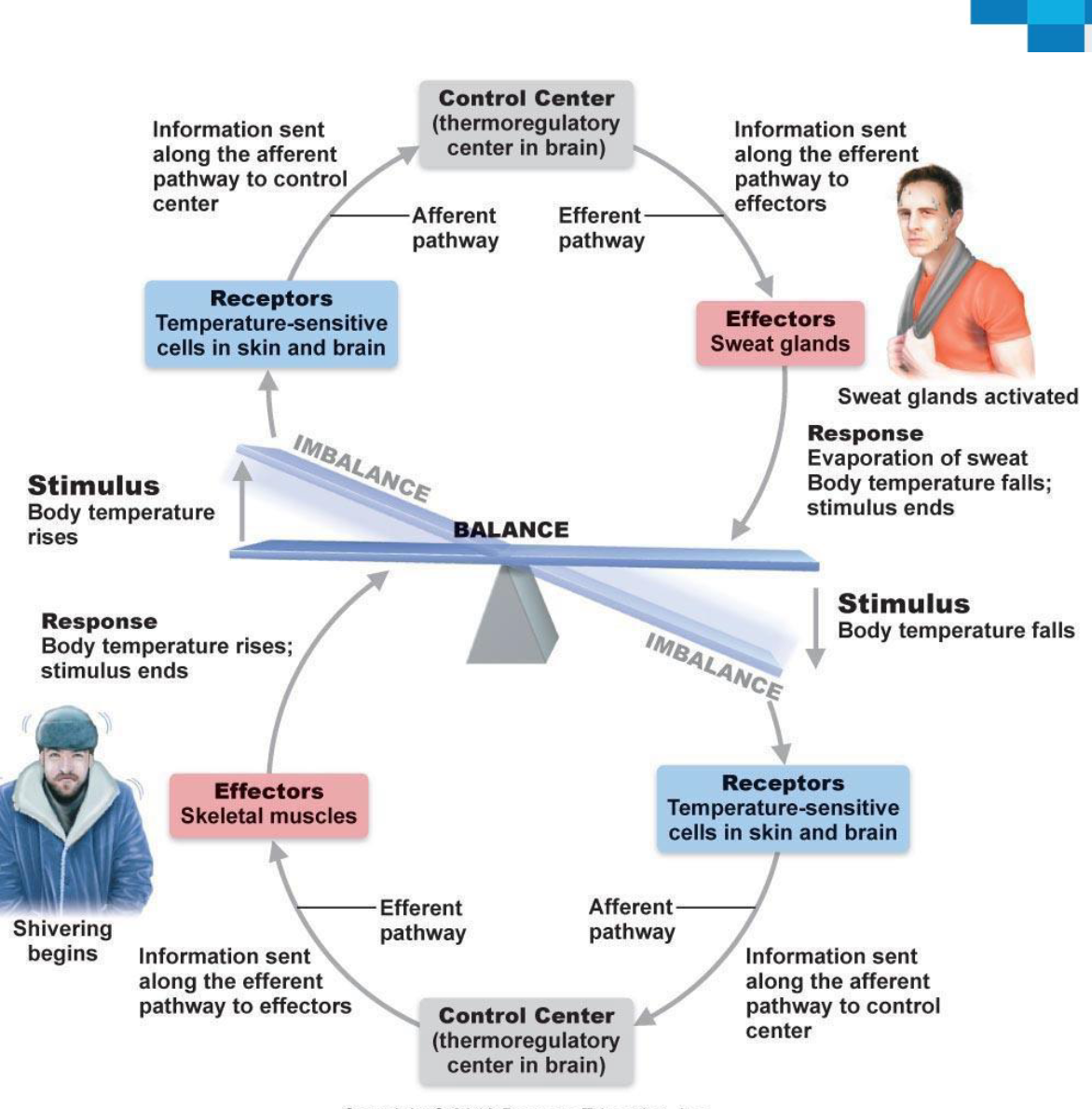
Positive Feedback
The response enhances or exaggerates the original stimulus
May exhibit a cascade or amplifying effect
Usually controls infrequent events:
Platelet plug formation and blood clotting
Negative Feedback: Glucose Regulation Example
Too much sugar (stimuli) → pancreas releases insulin (receptor)→ cells take up sugar & liver stores it (effector)→ blood sugar lowers
Low blood glucose (stimuli) → glucagon secretion (reseptor) → liver breaks down glycogen (effector) → glucose released into bloodstream
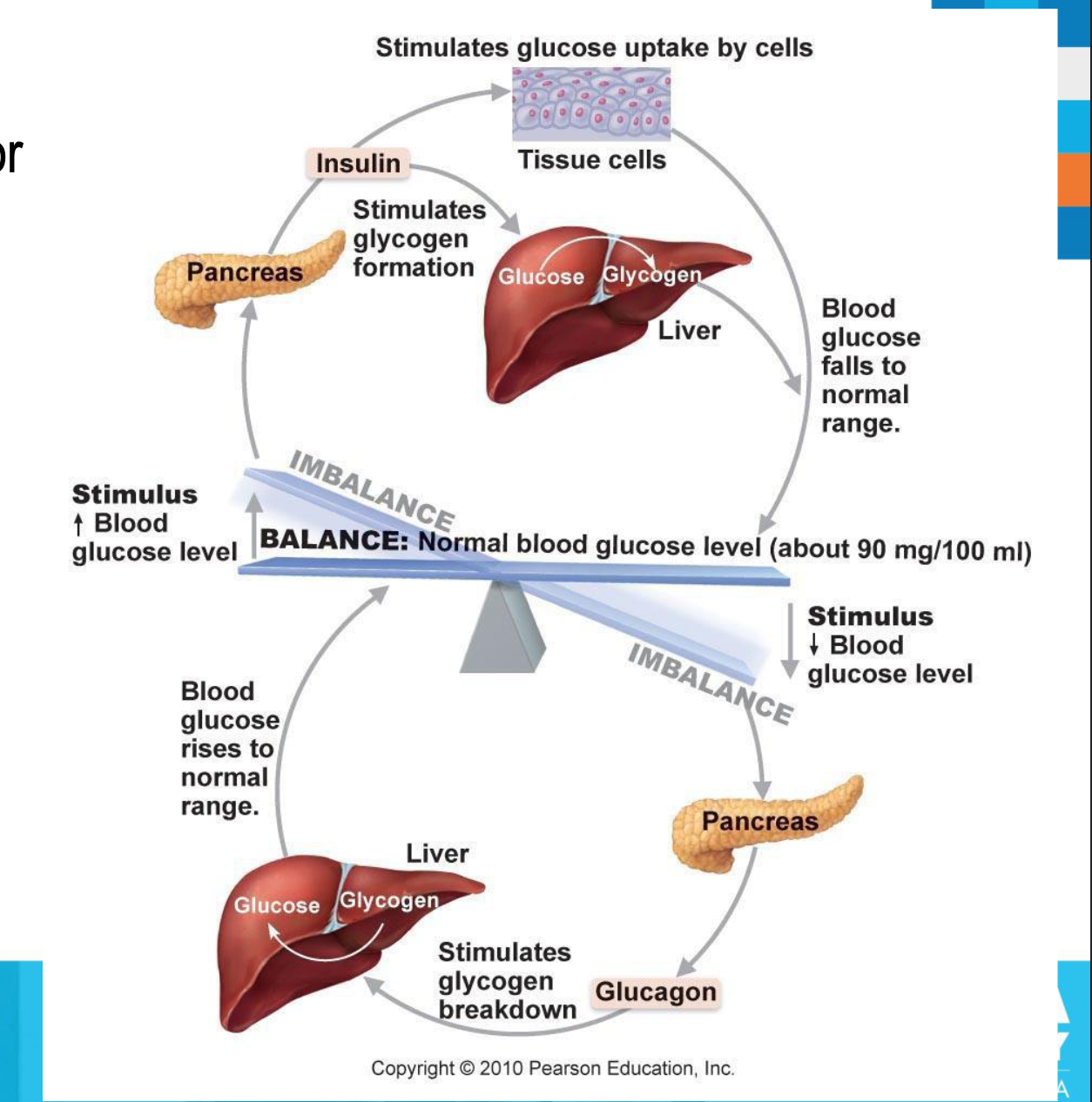
Clinical Case: Homeostasis
Susan, a 23-year-old student, went on a trip to a health spa with friends.
Susan sat in a sauna at a temperature of 77°C for ten minutes.
During this time, homeostatic mechanisms led to her body temperature remaining relatively constant.
Body Organisation
Chemical level: Atoms combine to form molecules.
Cellular level: Cells are made up of molecules.
Tissue level: Tissues consist of similar types of cells.
Organ level: Organs are made up of different types of tissues.
Organ system level: Organ systems consist of different organs that work together closely.
Organismal level: The human organism is made up of many organ systems.

Body System
A body system is a collection of organs that performs related functions e.g. Digestive system
Organs interact to accomplish a common activity essential for survival
Eleven systems:
Circulatory (cardiovascular)
Digestive
Respiratory
Urinary
Skeletal
Muscular
Integumentary (outer cover)
Immune
Nervous
Endocrine
Reproductive
Organ Systems and Their Components
Circulatory system: heart, blood vessels, blood
Digestive system: mouth, pharynx, esophagus, stomach, small intestine, large intestine, salivary glands, exocrine pancreas, liver, gallbladder
Respiratory system: nose, pharynx, larynx, trachea, bronchi, lungs
Urinary system: kidneys, ureters, urinary bladder, urethra
Skeletal system: bones, cartilage, joints
Muscular system: skeletal muscles
Integumentary system: skin, hair, nails
Immune system: lymph nodes, thymus, bone marrow, tonsils, adenoids, spleen, appendix, and white blood cells, gut-associated lymphoid tissue, skin-associated lymphoid tissue
Nervous system: brain, spinal cord, peripheral nerves, and special sense organs
Endocrine system: all hormone-secreting tissues, including hypothalamus, pituitary, thyroid, adrenals, endocrine pancreas, gonads, kidneys, pineal, thymus, parathyroids, intestine, heart, skin, adipose tissue
Reproductive system:
Male: testes, penis, prostate gland, seminal vesicles, bulbourethral glands, associated ducts
Female: ovaries, oviducts, uterus, vagina, breasts
Location of Organs: Body Cavities
Dorsal cavity: protects the nervous system
Two subdivisions:
Cranial cavity (encases brain)
Vertebral cavity (encases spinal cord)
Ventral cavity: houses the internal organs
Two subdivisions, separated by diaphragm
Thoracic cavity
Abdominopelvic cavity

Body Systems - Working together
Once you consider how each body system works in isolation we must consider how they work together
Tissues
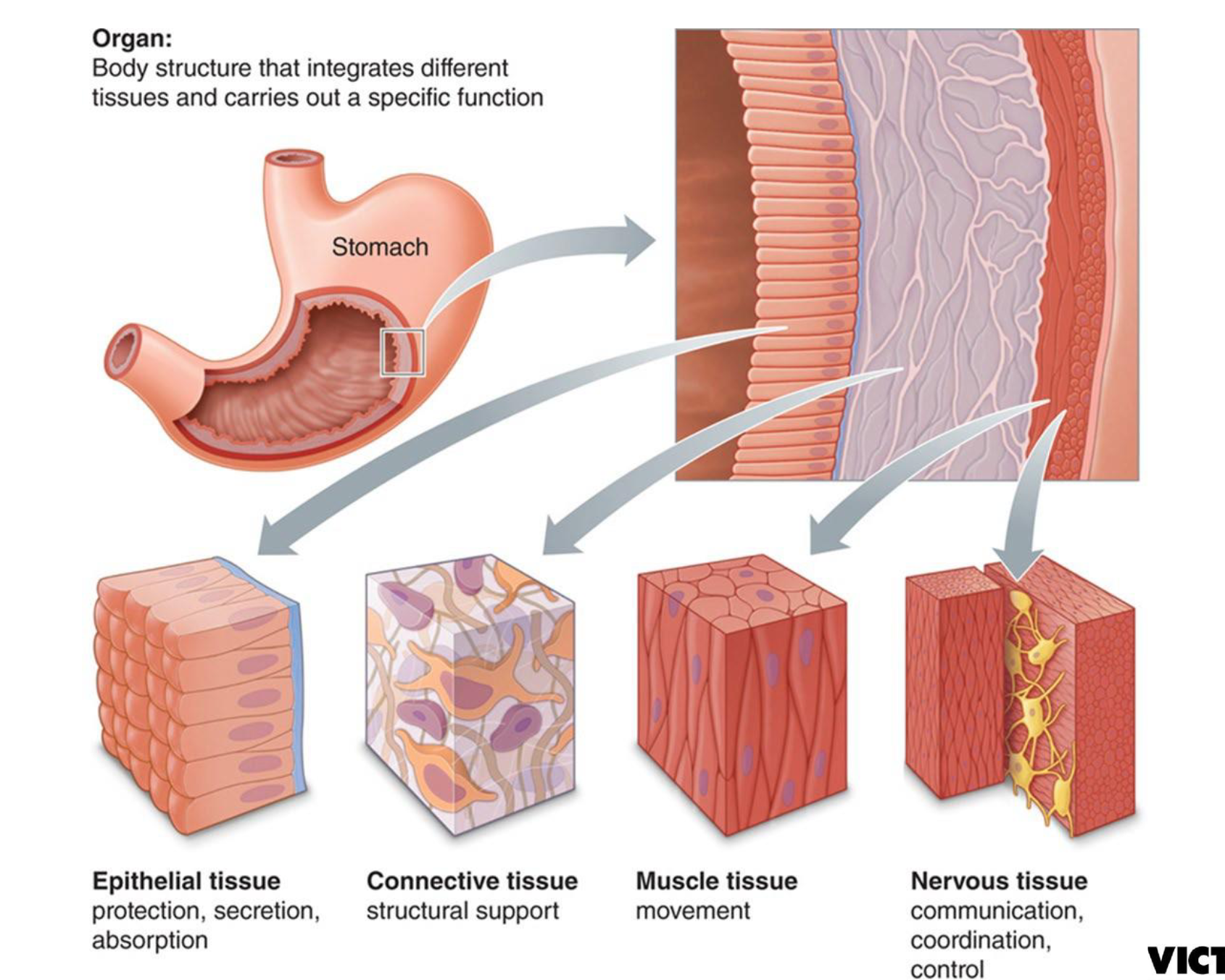
Organ
Body structure that integrates different tissues and carries out a specific function
Example: Stomach
Epithelial tissue: protection, secretion, absorption
Connective tissue: structural support
Muscle tissue: movement
Nervous tissue: communication, coordination, control
Epithelium
Covers exposed surfaces (e.g. skin) & lines internal passageways (e.g. GIT)
Protects the body’s internal environment
Regulates the exchange of materials between the internal & external environment
Consists of 1 or more layers of tightly connected epithelial cells
Basement membrane = boundary between epithelial tissue & connective tissue
Avascular but innervated-contains no blood vessels but supplied by nerve fibres
High rate of regeneration- rapidly replaces lost cells by cell division
Epithelium Classification
Epithelial tissue can be classified in two ways
Functionally – Exchange, transportation, protection, secretory
Structurally – by the shape of the cells and the number of layers of cells
Each tissue requires specific epithelial tissue to allow it to function
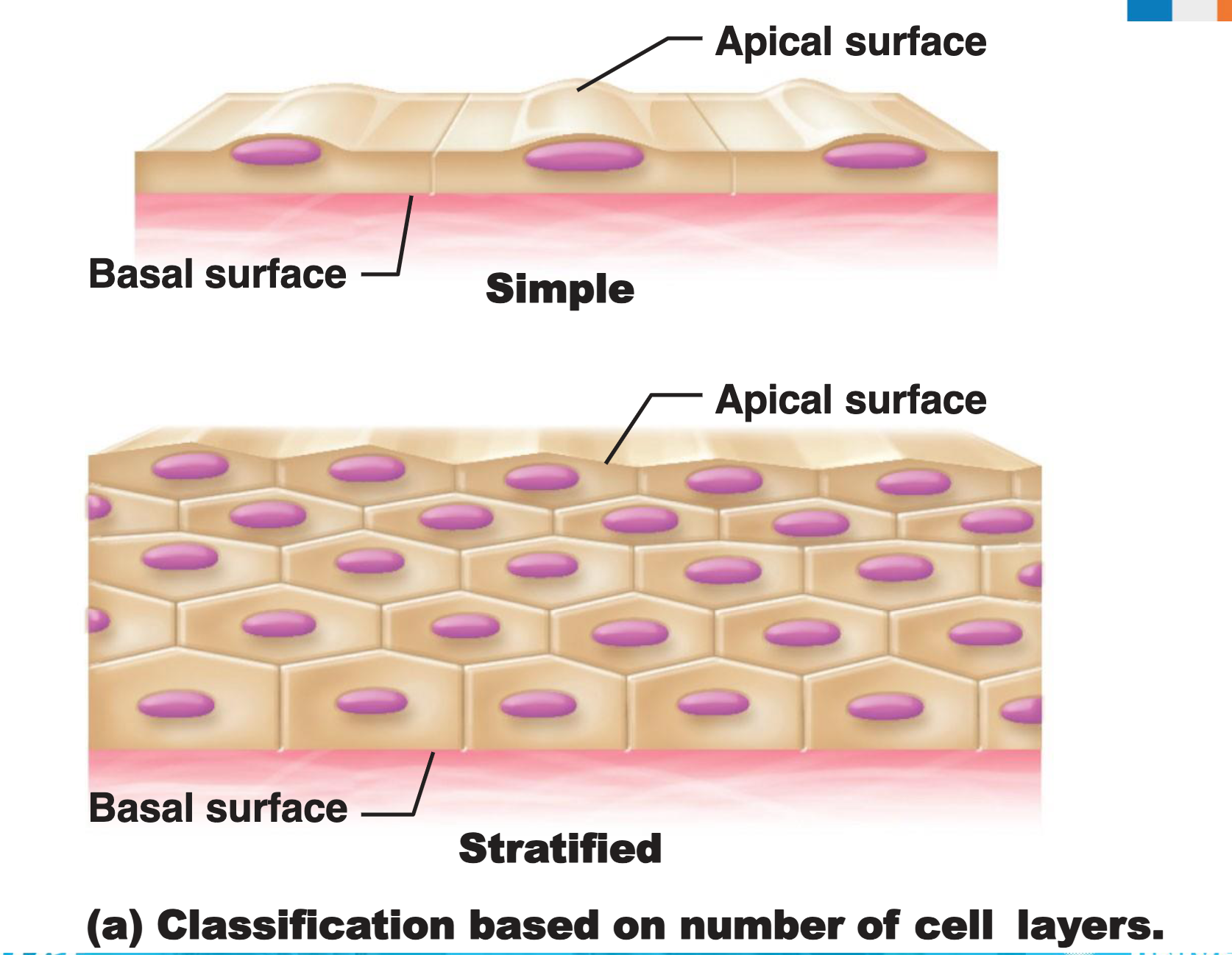
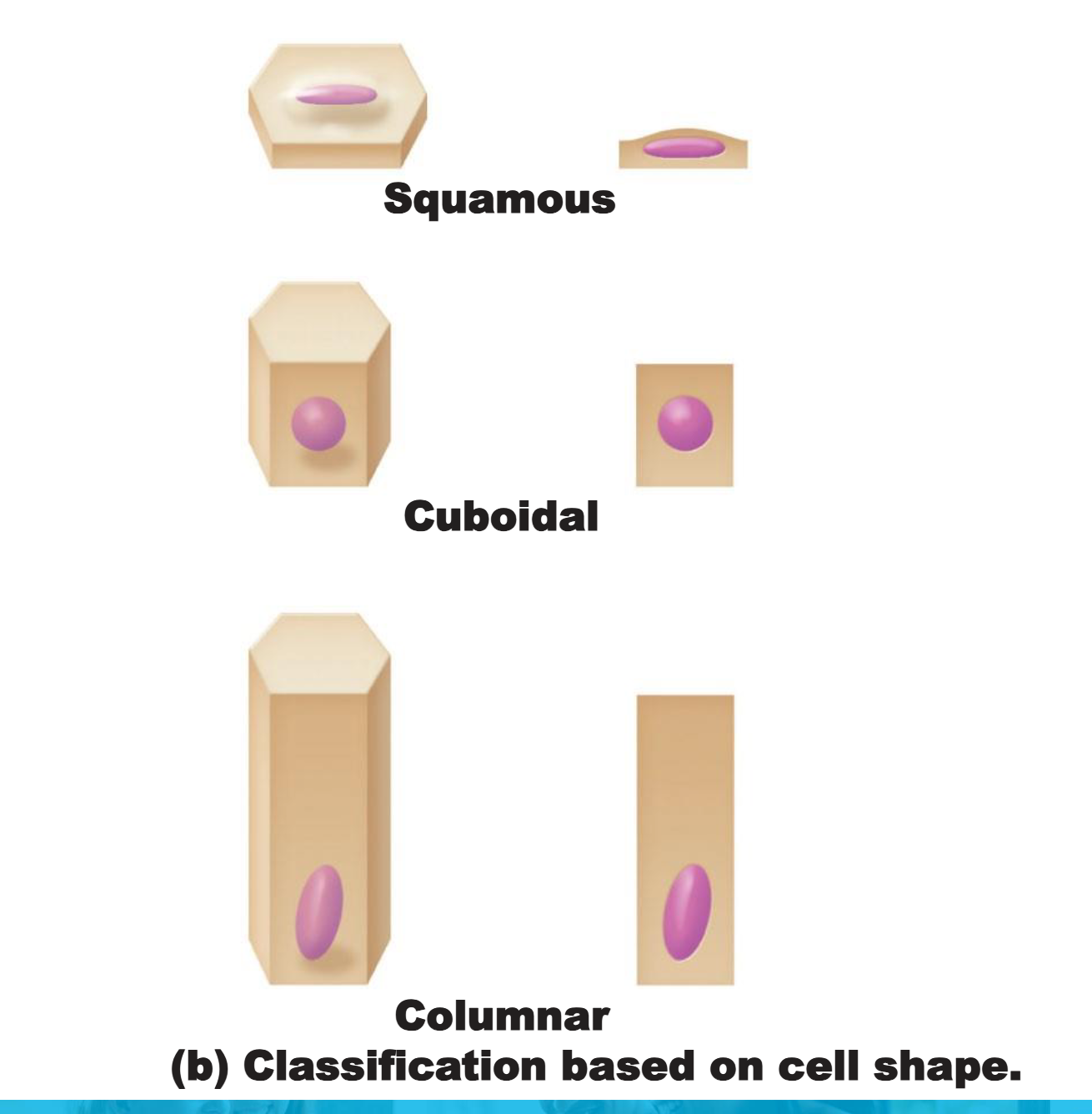
Summary- Epithelia: Simple
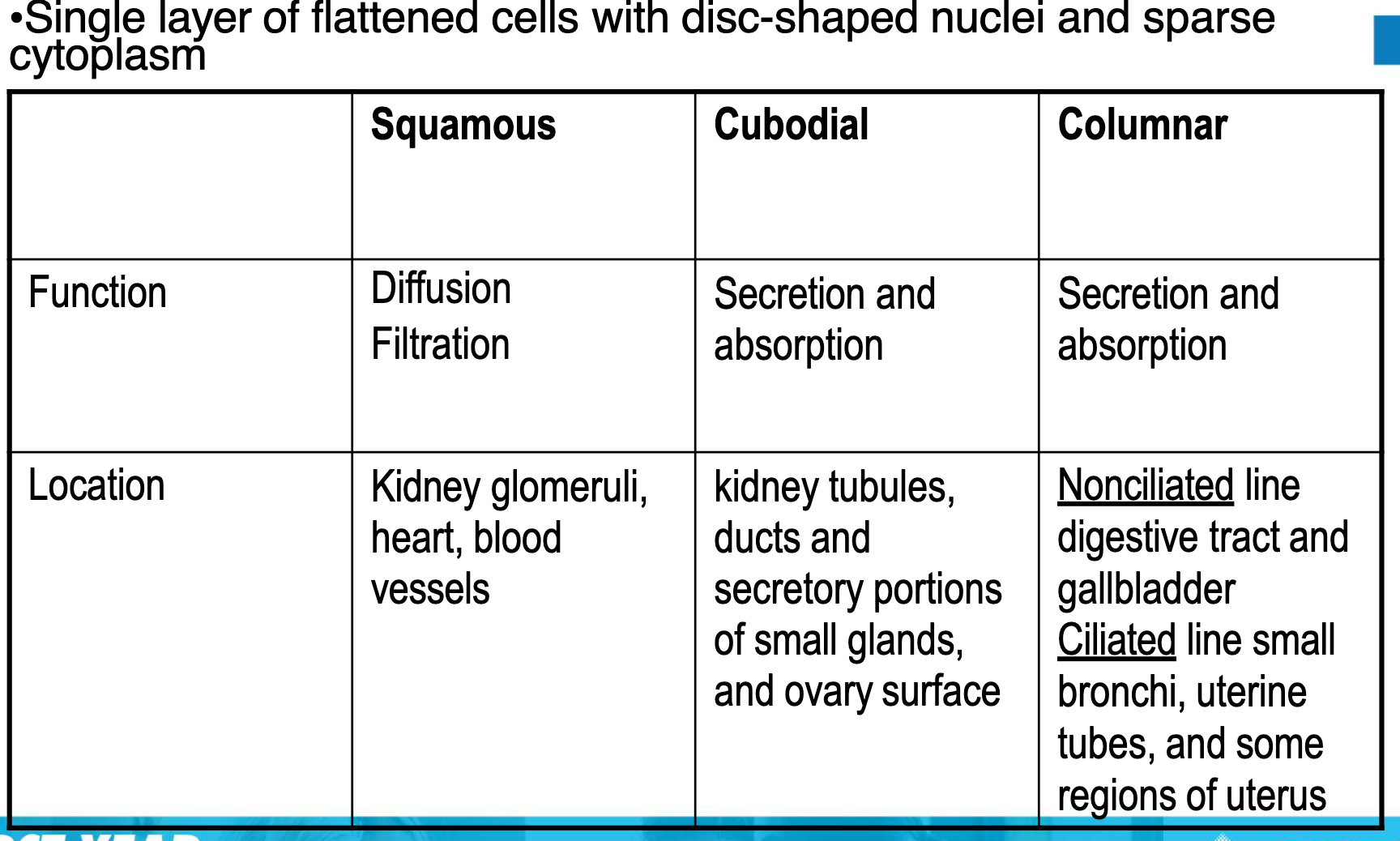
Connective Tissue
Four classes
Connective tissue proper
Cartilage
Bone tissue
Blood
Consists of cells within an extracellular matrix (ECM)
ECM consists of protein fibres (collagen, elastin, reticular) and specialized molecules (eg proteoglycans) that provides structural and biochemical support to the surrounding cells.
There are many types of connective tissue with quite varied structures and functions:
Many connective tissues bind other tissue types & organs together eg connective tissue proper
Provides support & protection eg bone, cartilage
Specialist tissues/functions include adipose tissue: insulation, fat/fuel storage and blood: transports substances around the body
Organ system level
1. Chamical level
celular level
tissue level
organ level
organ system level
organism level
Dual organ systems
Organ | Body Systems Involved | Functions |
|---|
Lungs | Respiratory, Excretory | Gas exchange, CO₂ removal |
Heart | Circulatory, Endocrine | Pumps blood, responds to hormones |
Brain | Nervous, Endocrine | Controls body and hormone release |
Skin | Integumentary, Excretory, Immune | Protection, sweat removal, pathogen defense |
Pancreas | Digestive, Endocrine | Enzymes for digestion, hormones for blood sugar |
Liver | Digestive, Excretory, Circulatory | Bile production, detoxification, blood filtration |
Kidneys | Excretory, Endocrine | Filter blood, hormone production |
Major tissue types

Major skin layers
Skin Layer | Main Function | Major Components |
|---|---|---|
Epidermis | Protection | Keratinocytes, melanocytes, no blood vessels |
Dermis | Support, sensation | Blood vessels, nerves, hair follicles, glands |
Hypodermis | Insulation, energy storage | Fat cells, large blood vessels, connective tissue |